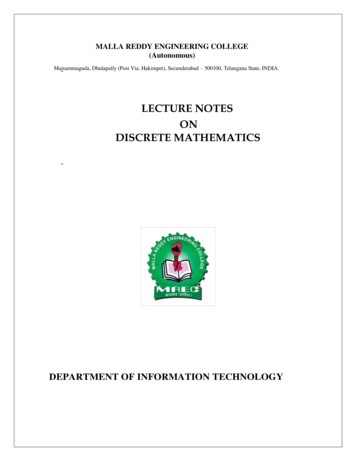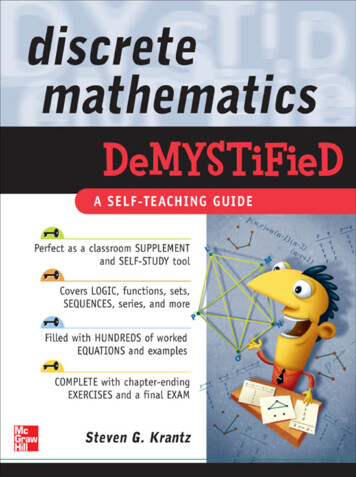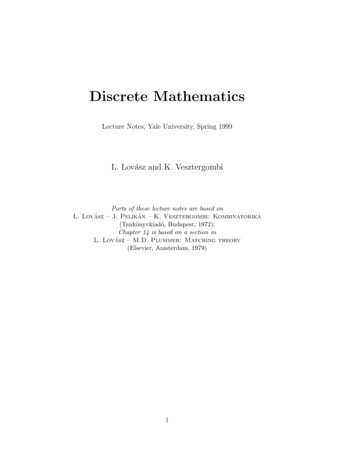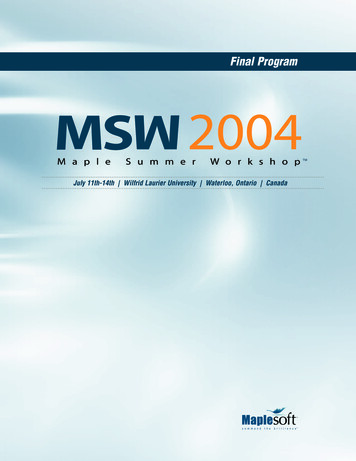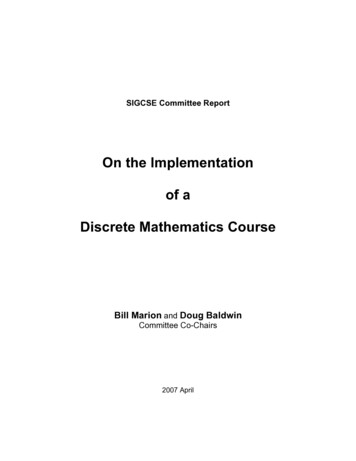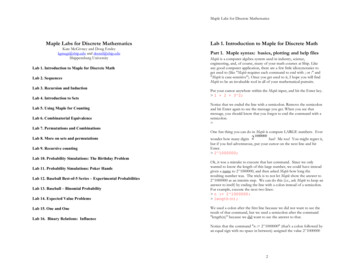
Transcription
Maple Labs for Discrete MathematicsMaple Labs for Discrete MathematicsLab 1. Introduction to Maple for Discrete MathKate McGivney and Doug Ensleykgmcgi@ship.edu and deensl@ship.eduShippensburg UniversityPart 1. Maple syntax: basics, plotting and help filesLab 1. Introduction to Maple for Discrete MathLab 2. SequencesLab 3. Recursion and InductionLab 4. Introduction to SetsLab 5. Using Maple for CountingLab 6. Combinatorial EquivalenceLab 7. Permutations and CombinationsLab 8. More on sets and permutationsLab 9. Recursive countingLab 10. Probability Simulations: The Birthday ProblemLab 11. Probability Simulations: Poker HandsLab 12. Baseball Best-of-5 Series – Experimental ProbabilitiesLab 13. Baseball – Binomial ProbabilityLab 14. Expected Value ProblemsLab 15. One and OneLab 16. Binary Relations: InfluenceMaple is a computer algebra system used in industry, science,engineering, and, of course, many of your math courses at Ship. Likeany good computer application, there are a few little idiosyncrasies toget used to (like "Maple requires each command to end with ; or :" and"Maple is case-sensitive"). Once you get used to it, I hope you will findMaple to be an invaluable tool in all of your mathematical pursuits.Put your cursor anywhere within the Maple input, and hit the Enter key. 1 2 3 2;Notice that we ended the line with a semicolon. Remove the semicolonand hit Enter again to see the message you get. When you see thatmessage, you should know that you forgot to end the command with asemicolon. One fun thing you can do in Maple is compute LARGE numbers. Ever1000000has? Me too! You might regret it,wonder how many digits 2but if you feel adventurous, put your cursor on the next line and hitEnter. 2 1000000;Ok, it was a mistake to execute that last command. Since we onlywanted to know the length of this large number, we could have insteadgiven a name to 2 1000000, and then asked Maple how long theresulting number was. The trick is to not let Maple show the answer to2 1000000 as an interim step. We can do this (i.e., ask Maple to keep ananswer to itself) by ending the line with a colon instead of a semicolon.For example, execute the next two lines: n : 2 1000000: length(n);We used a colon after the first line because we did not want to see theresult of that command, but we used a semicolon after the command"length(n)" because we did want to see the answer to that.Notice that the command "n : 2 1000000" (that's a colon followed byan equal sign with no space in between) assigned the value 2 10000002
Maple Labs for Discrete MathematicsMaple Labs for Discrete Mathematicsto the variable n. Assignments like this come in handy any time youwant to refer back to an expression later or when you want to keepexpressions as simple as possible. For example, the following assignsand the range of its values (0 to 10) over which the expression's graphwill be plotted. Before continuing, answer the following questionsabout this graph.xthe expression 2 to the name f, and the number f : 2 x; a : sqrt(2);2to the name a.The Maple command evalf is probably the most commonly usedcommand, so you might as well start now. It merely returns a floatingpoint evaluation of the input.We can now use the evalf command to see a floating point evaluation ofa. evalf(a);Another pretty natural thing to want to do is to substitute the number ainto the expression f. Most people think that this should be written f(a),but if you try that below you will see that you get a weird answer, notwhat you wanted. f(a);There is a Maple command which does the correct thing though. Toremember it, you must remember that what you really want to do hereis to take the expression whose name is f and substitute for the letter xin it the value of a . Here are two examples of the substitutioncommand. subs(x a, f); subs(x sqrt(2), x 2);TRY THIS. Did you notice that Maple did not give you a number forthe answer in the first case above? Go back and wrap the evalf( )command around each the first expression above to see what thenumerical value is. Remember that the semicolon should still come atthe end of the line.PlottingOne of the most useful features of Maple is its graphics capabilities. Thesyntax for plotting is pretty simple. For example, try the following: plot(x 2 - 4*x - 50,x 0.10);So the plot command requires only two arguments: The first is theexpression to be plotted, the second gives the independent variable (x)3TRY THIS. What is the exact value (to two correct decimal places) ofx shown where the graph crosses the x-axis? What will be the othervalue of x where the graph crosses the x axis? (Think about it, and thenchange the command accordingly to see if you are right.)In Discrete Math, we often work with sequences, where for each entrythere is a next entry (and not necessarily any in between). In Maple, thisis called a "point plot," and it has a syntax very similar to the commandabove. plot([[1,2], [3, 4], [2, 5]], x 0.4, y 0.5,style point, color blue);The square brackets above are what Maple uses to denote a "list". Wewill visit this structure many times in this course.Help filesThe single most important thing to be able to do in Maple is USE THEHELP FILES. This is because Maple has more capabilities than canever be addressed in a single course, so you are best off learning how tofigure out how to make Maple do any new thing you want throughjudicious use of its built-in help files. You can get into the help filesthrough the Help Browser in the menus, but it is often hard to findwhat you want there. A better thing to do is to type ? cmdname.This brings up the specific help file for cmdname which includes syntax,examples and related commands. For example, suppose we want tocompute the average value of the first 100 positive perfect squarenumbers (1, 4, 9, 16, etc.). To do this we need to add up the first 100perfect squares and divide by 100. Start with asking for help with "add"with the command line below, and then try to figure out how to get theanswer to this question. ?addTRY THIS. The average of the first 100 positive perfect squares is3383.5, which is not a whole number. Find three values of n so that theaverage value of the first n positive perfect squares is a whole number.What do your values have in common?Part 2. Functions4
Maple Labs for Discrete MathematicsMaple Labs for Discrete MathematicsOne thing that computers force you to do is to be consistent with yourchoice of defined structures. We saw above that we got gibberish whenwe defined an expression f and tried to compute f(a). Let's see it againhere: f : 2 x; f(3); g(p-1);We solved the problem before by pointing out that we are really tryingto "substitute 3 for x in f" and so we used the appropriate subscommand to do what we meant to do. The math notation f(3) isreserved for use when f is a function, not an expression. There is adifference as we shall see. To define g to be the function that takes anumber x as input and returns the numberfollowing assignment: g : x - 2 x;2xas output, we make theNote that we can now use functional notation to refer to putting anumber or expression as input into a function definition. g(3); g(p-1);This type of definition is appropriate only when we have an algebraicexpression (i.e., a closed formula) for the numbers we are trying togenerate. We have seen in Section 1.2 however, that it is often easier tofind a recursive formula instead. We finish this introduction byshowing how to implement such a description in Maple.Part 3. ProceduresMaple is actually a fully-supported programming language whichhappens to have extensive built-in mathematics functions and symbolicalgebra capabilities. Instead of being a compiled language, Maple isinterpreted, which means that errors are checked as the commands arebeing executed. Consequently, Maple's error messages are not ashelpful as you might be used to.Here is an example of a procedure that simply performs the same taskthe function g above. g : proc(x)RETURN(2 x)end; g(3);5The procedure below is intended to compute entries in the sequence 3,7, 11, 15, . in which each term is 4 more than the previous term. Writea recursive description of this sequence first, and then try to see howeach component of your definition are realized in the procedure below.(Note: To get the input spread over several lines, I simply held the shiftkey down while hitting Enter at the end of the first three lines, and thenhit Enter alone after the fourth line to execute the entire block.) a : proc(n)option remember:if (n 2) then RETURN(3) else RETURN(a(n-1) 4) fiend; a(1); a(2); a(3); a(4); a(5);We conclude this introduction by presenting one more command thatallows us to see many values of a sequence, whether defined byprocedure or function, so that we can investigate its patterns. Thecommand seq creates a list of numbers according to a rule over aspecified range of input numbers. For example, the following commandlists the first five values of the sequence a that we computed above oneat a time. seq( a(i), i 1.5);And the next command lists the first ten positive perfect squares: seq( i 2, i 1.10);TRY THIS. Alter the above definition of a so that you get each of thefollowing sequences. Use the seq command to check. 1, 3, 7, 15, 31, . 2, 6, 10, 14, 18, . 2, 5, 9, 14, 20, .6
Maple Labs for Discrete MathematicsMaple Labs for Discrete MathematicsLab 2. Sequencesto the sequence’s recursive form. Finally verify that your conjecture isvalid by modifying the script so that it contains the recursive form.In this lab activity we’ll use Maple to discover a closed formula given arecursive sequence and vice-versa.Consider the sequencea n a n 1 2n 1 where a1 1for n 2 . Using the following Maple script, we can quickly see thefirst 20 terms of this sequence.a: array(1.20):a[1]: 1:print(1,a[1]);for i from 2 to 20 doa[i]: a[i-1] (2*i 1):print(i,a[i]);od:a n 3 n 1.Recursive Form:a n 3n 2 n.Recursive form:a n 2 2 n 1 1Recursive form:What do you think is the closed form for this sequence?Check your conjecture by modifying the above script so that the closedform replaces the recursive form.For each of the following recursive sequences modify the above scriptso that it produces the first 20 terms of each sequence. Next, make aconjecture about the recursive sequence’s closed form. Check yourconjecture by modifying the script.a n 4 a n 1; a1 2.Closed Form:a n 2a n b; a1 1.Closed Form:For each of the following sequences given in closed form, modify theabove script to produce the first 10 terms. Then make a conjecture as78
Maple Labs for Discrete MathematicsMaple Labs for Discrete MathematicsLab 3. Recursion and Induction S(2); S(3); S(4);We have seen a couple of examples already of recursive thinking. Thetool we will use to prove things about recursively defined structures iscalled "the Principle of Mathematical Induction." This lab will illustratethe connection while allowing you to practice the proof technique. Youwill need Maple for the computer part and pencil and paper for thewriting part. It is also helpful to have a partner with whom you can talkthings through.Enter the following new function definitions and then answer (amongyourselves) the question that follows. (NOTE: To get a new linewithout beginning Maple execution, hit "Shift Enter" at the end of theline.) F : proc(n)options remember;if (nc 3) then RETURN(1)else RETURN(F(n-1) F(n-2))fiend; S : proc(n)options remember:if (n 0) then RETURN(0)else RETURN(S(n-1) n)fiend;Problem 2. Copy the definition of S and edit it to create a new recursivefunction called oddSum that given an input of n returns the sum of thefirst n odd numbers.Problem 3. What problem that we worked on already is addressed by thefollowing recursive function? (The function isPowerofTwo is not a builtin Maple function. It is defined by the first line below, and it returnstrue when its argument is an integer power of 2 and false otherwise.) isPowerofTwo : x - evalb(type(simplify(log[2](n)),integer)); B : proc(n)options remember;if isPowerofTwo(n) then RETURN(1)else RETURN(B(n-1) 2)fiend;We will discuss the "options remember" part of these procedures whenwe discuss recursive algorithms later in the course. To use these newcommands, you simple treat them like any other Maple commands. Forexample, execute the next few lines, and then once you've seen thegeneral syntax you can explore some more on your own. The problemyou should be investigating is simple:Problem 1. Describe in words what F and S compute. F(3); F(4); F(5);910
Maple Labs for Discrete MathematicsMaple Labs for Discrete Mathematics A union B;Lab 4. Introduction to SetsIn this activity we will explore various set operations. Given theuniversal set U: {0,1,2,3,4,5,6,7,8,9,10,11,12,13,14,15} use thefollowing Maple commands to generate random subsets A, B, and C ofsize 3, 5, and 7, respectively. with(combinat, randcomb);randomize();U: {0,1,2,3,4,5,6,7,8,9,10,11,12,13,14,15};A: randcomb(U,3);B: randcomb(U,5);C: randcomb(U,7);Use the randomly generated sets to determine the following.A B The intersection command is A intersect B;To find the set A-B, type A minus B;Maple does not have a built in “complement” command. How can youuse one of the above commands to find the complement?The power set of a set A can be found by typing the followingcommands: with(combinat, powerset); powerset(A);Lastly, to find the Cartesian product of two sets, A and B, use thefollowing Maple commands. union ( op(map(y - map(x- [x,y],A),B)) );( A C) B Randomly generate sets A, B, and C again. Answer the followingquestions without Maple and then use Maple to check your answers.A B A B A' ( A C) B A (B C) A B A B A B A' B A' P ( A) A (B C) AxB A' B Next we’ll see how we can use Maple to check our answers. To find theunion of sets A and B, simply type11P ( A) 12
Maple Labs for Discrete MathematicsLab 5. Using Maple for CountingAxB Are each of the following properties true or false? We’ll use Maple togenerate some conjectures. For those that are not true, provide aspecific counterexample.1. A ( B C ) ( A B ) C2.Maple Labs for Discrete MathematicsA ( B C ) ( A B) ( A C )3. P ( A) P ( B ) P ( A B ).Maple has a combinatorics package that has many nice tools to help uslearn about counting. Execute the following command to load thecombinatorics package: with(combinat);Don't forget that you can ask for help on any of these commands tofind out more about them. For example, we will use the permutecommand, look at the help file by executing the following line. Onceyou have looked it over, select "Close Help Topic" under the File menu,and you will be returned to where you left. ?permuteSo for example, if want to list all permutations of length 2 with entriestaken from {a, b, c, d}, we would use the following command: permute([a,b,c,d],2);The command nops will count the number of items in any list for you.So the command nops( permute([a, ,b, c, d], 2) ); should return thenumber of permutations in the above list. Try it below.Problem 1. Draw a "game tree" with two branchings that generates theabove list. Can you see how the number of branches is related to thenumber of permutations generated? Test your hypothesis by thinkingabout the structure of the game tree for permute([a,b,c,d,e,f,g,h,i,j],2),predicting the number of permutations that will be generated, andtesting your prediction using the nops command.Unfortunately Maple does not have a similar command that generatesall ordered lists, so we have to write one. Execute the block of codebelow to define the new command, orderedLists, which we will use next. orderedLists : proc(S,k)local i, L:L : NULL:for i from 1 to nops(S) doL : L, seq(S[i],j 1.k)od:RETURN(permute([L],k))end; orderedLists([a,b,c,d],2);1314
Maple Labs for Discrete MathematicsMaple Labs for Discrete MathematicsProblem 2. Draw a "game tree" with two branchings that generates theabove list. Can you see how the number of branches is related to thenumber of ordered lists generated? Test your hypothesis by thinkingabout the structure of the game tree for orderedLists([a,b,c,d,e,f,g,h,i,j],2),predicting the number of ordered lists that will be generated, and testingyour prediction using the nops command.Lab 6. Combinatorial EquivalenceClaim: The following two questions have the same answer.ooHow many 2-element subsets of the set {1,2,3,4,5} are there?How many 3-element subsets of the set {1,2,3,4,5} are there?Why is this? Use Maple to generate all possible 2-element and 3element subsets of {1,2,3,4,5}. Here is the appropriate command: choose([1,2,3,4,5],n);where n is the size of the subset.Based on the output, can you explain the answer to a beginning discretemath student?How many 2-element subsets of the set {1,2,3,4,5,6} are there?How many 4-element subsets of the set {1,2,3,4,5,6} are there?In general, explain why the number of k-element subsets of the set{ x1 , x 2 ,., x n } is always equivalent to the number of n-k elementsubsets of the set { x1 , x 2 ,., x n } .Claim: The following two questions have the same answer.ooHow many ways are there to flip 3 heads in 5 tosses of acoin?How many 3-element subsets of {1,2,3,4,5} are there?We’ll use Maple to investigate why this is true.In the first case, we want to determine the number of ways to flip 3heads in 5 tosses. In other words, we want to determine the number ofways to order 3 heads and 2 tails. Therefore the appropriate Maplecommand is permute([H,H,H,T,T],5);Generalize the previous result: The number of ways to flip k heads in ntosses is the same as .1516
Maple Labs for Discrete MathematicsMaple Labs for Discrete MathematicsLab 7. Permutations and Combinationsn333r023In this lab we’ll develop a formula that relates the number of subsetsand the number of permutations that can be formed from n distinctobjects. Recall that the difference between subsets and permutations isthat in the first case we don’t care about the order of the entries and inthe second case we do.Helpful counting discrete math Maple commands are bundled together.To access these commands, type: with(combinat);The Maple command permute(n,r)generates the permutations ofsize r from a set of n distinct elements. Recall that our text used thenotation P(n,r) to represent the number of permutations of size r fromthe set of n objects.P(n, r)C(n, r)Now let’s look at a slightly greater set, one that contains 4 distinctentries. Use the permute(n,r) and the choose(n,r)commandsto find all permutations (subsets) of size r. Fill in the number ofpermutations (subsets) for each choice of r in the following table:n444r012Execute permute(n,r); for the following choices of n and r.P(n, r)nrC(n, r)30313233What is P(n,r) in each case?Next, we’ll compute the number of subsets of size r from a set of ndistinct elements. Since now we do not care about the order of theentries, [1,2] and [2,1] are considered “equivalent”. Count the numberof subsets that arise in each of the above cases.n3r0313323344Can you use the previous tables to come up with a formula that relatesP(n, r) and C(n, r) ? Explain why this formula makes sense.Number ofSubsetsThe Maple command choose(n,r) constructs the subsets of sizer that can be formed from n objects. Our text represents the number ofsubsets of size r that can be formed from n objects by the notationC(n,r).17418
Maple Labs for Discrete MathematicsMaple Labs for Discrete MathematicsLab 8. More on sets and permutationsTry this! Use the C and P functions we just defined to explore which ofthe following statements are true.In this lab we will explore the difference between the structurespermutations and sets. We will look at formulas for counting each type ofobject, and then we will try some more sophisticated investigationsusing the computers.First execute the following command in order to load some helpfulDiscrete Math-ish Maple commands. with(combinat);Now compare the output of the following commands. How muchlonger is the first output list than the second? Think of how you wouldexplain this precise difference to a classmate. permute(5,3); choose(5,3);Technically, one of the above commands lists permutations and theother lists sets. Since Maple uses the square brackets [ and ] for theoutput in both, it is not obvious which is which. Can you tell based onwhether order matters or not?In the text, we use the notation P(5,3) for the number of permutationsof length 3 with entries taken from {1,2,3,4,5}, and the notation C(5,3)for the number of sets of size 3 with entries taken from {1,2,3,4,5}. (Inother words, C(5,3) counts 3-element subsets of {1,2,3,4,5}.) Using thenops command (remember how it tells you how many things are in along list), compare P(7, 3) and C(7, 3). Is this what you expected?We can now write (as we do in the text) formulas for P and C. We havealready talked about the theoretical basis for these in the last class, butnow we want to be sure we understand what P and C are counting andhow they are related. The following functions are not built into Mapleso you will have to define them before you ever use them. P : proc(n, k)RETURN(product(n-j, j 0.(k-1)))end; C : proc(n, k)RETURN(P(n,k)/k!)end; P(5, 3); C(5, 3);19(1)(2)(3)(4)C(n, k) C(n - 1, k) C(n - 1, k - 1)P(n, k) P(n - 1, k) P(n - 1, k - 1)P(n, k) n * P(n - 1, k - 1)C(n, 0) C(n, 1) C(n, 2) . C(n, n) 2nThe Binomial TheoremOne of the important ideas throughout the course is the fact that thereis great benefit in understanding many different answers to problemsbecause from that understanding comes the ability to tell how differentquestions are related to one another.The distributive law of multiplication over addition tells us that whenwe expand (a0 a1)*(b0 b1) we form terms by choosing eachpossibility from the first factor and each possibility from the secondfactor and multiplying them together. The terms so formed are thenadded together. Look at the expansion below to see if this makes sense: expand( (a0 a1)*(b0 b1));Now expand the following to see how the distributive law generalizeswhen you multiply three things together. expand( (a0 a1)*(b0 b1)*(c0 c1));How many terms in the above expression have two "1"s in them? Howmany terms with two "1"s will be in the expansion of(a0 a1)*(b0 b1)*(c0 c1)*(d0 d1)? Check below.The following question is related to the previous one by using powersof 0 and 1 on a single variable x. (Look for the analogy to the previousdiscussion.)( x0 x ) ( x0 x ) ( x0 x ) , what will be the2coefficient of x ?0000In the expansion of ( x x ) ( x x ) ( x x ) ( x x )If we expand? expand( (x 0 x 1) 3);If we formally make an analogy to binary sequences in the comparableexpansions we will have explained .20
Maple Labs for Discrete MathematicsMaple Labs for Discrete MathematicsThe Binomial Theorem. The coefficient of(1 x)nxkin the expansion ofis C(n, k).Pascal's TriangleWe can make a nice table of values by placing C(n,k) in Row n, Entry kof our table. Since we have to allow for values like C(5,0), we will thinkof rows starting with "Entry 0" instead of "Entry 1," and in the samespirit, we will call the top row, Row 0 rather than Row 1. In thisfashion, the values in the first three rows of our table will come fromthe following: C(0,0); C(1,0); C(1,1); C(2,0); C(2,1); C(2,2);These can be filled in our table in a triangular shape as shown below.This is the first part of what is known as Pascal's Triangle.Lab 9. Recursive countingIn this lab we will look at some recursive counting techniques andimplement them with recursive Maple programs. You will not have towrite code from scratch, but you will need to be able to read and modifyexisting code.Example 1. Why is P(n, k) n * P(n - 1, k - 1)?Consider the question, "How many permutations of length k use entriesfrom {1, 2, ., n}?" We know the answer is P(n,k), but let's see anotherway to get this value.To answer this, we can use a TWO-step decision process:(1) Choose a first entry from {1, 2, ., n}(2) Fill in the remaining k - 1 entries with a permutation of length k - 1using entries from the other n - 1 elements of the setWe can analyze this algorithm using the product rule: There are clearlyn choices for the first step, and by definition of P, there are P(n-1,k-1)ways to do the second step. Hence by the product rule, there are n * P(n- 1, k - 1) permutations generated by the algorithm. Therefore this isthe same thing as P(n,k).Notice that this relationship does not help if k 0, so it is alsonecessary to specify that P(n, 0) 1 for this recursive formula to makesense.(1) Fill in the next two rows of Pascal's Triangle.(2) Express the visual pattern between rows of Pascal's Triangle inwords.(3) Express the same pattern using the C notation.(4) Make a conjecture about the sum of the values in Row n of Pascal'sTriangle.(5) State your conjecture using the C notation.21The following Maple program implements this idea: P : proc(n, k)option remember:if (k 0) thenRETURN(1)fi;RETURN( n * P(n - 1, k - 1));end;(A) Compare P(6, 2) or P(10, 3) with the result we would get using ourregular formula from the text.22
Maple Labs for Discrete MathematicsMaple Labs for Discrete Mathematics(B) We saw before that numbers like P(2, 5) make sense to ask about -they simply have a value of 0. (That is, there are 0 permutations oflength 5 with entries taken from {1, 2}.) Does the above procedure dealwith these unusual cases correctly? If not, how do you fix it?The following Maple program implements this idea: C : proc(n, k)option remember:if (k 0) thenRETURN(1)fi;if (k n) thenRETURN(0)fi;RETURN( C(n - 1, k) C(n - 1, k - 1));end;Example 2. Why is C(n, k) C(n - 1, k) C(n - 1, k 1)?Consider the question, "How many binary sequences of length n useexactly k 1's?" We know the answer is C(n,k), but let's see another wayto get this value.To answer this, we can use a TWO-step decision process:(1) Choose a first entry from {0,1}(2) Fill in the remaining n - 1 entries with a binary sequence of length n- 1.The trouble is that the number of ways to do step 2 DEPENDS onwhether we took a 0 or a 1 in step 1, so to remedy this, we use cases:CASE I. Suppose the first entry is a 0. In this case, there is one way todo step 1, and then in step 2, we must be sure that our n - 1 digit binarysequence has exactly k "1"s -- there are C(n - 1, k) ways to do step 2. Bythe product rule, there are C(n - 1, k) binary sequences like this. (i.e.with n digits, k of which are 1s, and starting with a 0).CASE II. Suppose the first entry is a 1. In this case, there is one way todo step 1, and then in step 2, we must be sure that our n - 1 digit binaryCompare the value of C(6, 3) and C(10, 2) with this procedure to whatyou get from the formulas in our text.Example 3. How many n digit binary sequences donot have adjacent 1's?Let b(n) represent this number. Obviously b(1) 2 because bothpossible binary sequences of length 1 fail to have adjacent 1's. On theother hand, b(2) 2 since only the sequences 00, 10 and 01 qualify.What is b(3)? What is b(4)? Do you see a pattern?Claim: The number of binary sequences of length n having noadjacent 1's is b(n-1) b(n-2).To see this, imagine the two step algorithm for forming binarysequences of length n having no adjacent 1's: (1) Choose a first digit, (2)choose the remaining digits as a binary sequence of length n - 1 withoutadjacent 1's. The problem is that step (2) might not work when a 1 ischosen in step (1), so once again, we break the problem into cases.sequence has exactly k - 1 "1"s -- there are C(n - 1, k - 1) ways to dostep 2. By the product rule, there are C(n - 1, k - 1) binary sequences likethis. (i.e. with n digits, k of which are 1s, and starting with a 1).Case 1. If the first digit of the sequence is a 0, then there's 1 way to doHence by the sum rule, there are C(n - 1, k) C(n - 1, k - 1) binarysequences generated by this algorithm. Therefore this is the same thingas C(n,k).Case 2. If the first digit of the sequence is a 1, then the only allowablestep (1) and b(n-1) ways to do step 2. Hence there are b(n-1) binarysequences of length n having no adjacent 1's and beginning with a 0.Notice that this relationship does not help if k 0 or if k n, so it isalso necessary to specify that C(n, 0) 1 and that C(n, k) 0 if k n forthis recursive formula to make sense.sequences to use in step 2 are those that start with a 0. By the argumentin Case 1, there are b(n-2) binary sequences of length n - 1 having noadjacent 1's and beginning with a 0, so this is the number of ways tocomplete step 2 in this case. This means there are b(n-2) binarysequences of length n having no adjacent 1's and beginning with a 1.2324
Maple Labs for Discrete MathematicsMaple Labs for Discrete MathematicsAdding the numbers for the two cases together gives us the number ofbinary sequences of length n without adjacent 1's. That is, b(n) b(n-1) b(n-2).Lab 10. Probability Simulations: The BirthdayProblemWe can implement this in Maple as follows: b : proc(n)if n 1 then RETURN(2) fi;if n 2 then RETURN(3) fi;RETURN(b(n-1) b(n-2));end;What is the probability that at least two of the 32 students in the class share thesame birthday?Exercises.(1) Modify the above argument to count the number of binarysequences of length n which do not have THREE consecutive 1's.(2) How many ordered lists of length 5 with entries from {1,2,3,4,5,6}have entries summing to 20? (Hint: Let d(n,k) the number of ways tohave a list of length n with entries summing to k, and show that d(n, k) d(n-1, k-1) d(n-1, k-2) d(n-1, k-3) d(n-1, k-4) d(n-1, k-5) d(n-1, k-6). Then implement this in Maple and compute d(5, 20).)The following script produces a random s
Maple Labs for Discrete Mathematics Maple Labs for Discrete Mathematics 6 One thing that computers force you to do is to be consistent with your g(p-1); choice of defined structures. We saw above that we got gibberish when we defined an expression f and tried to compute f(a). Let's see it again here:
